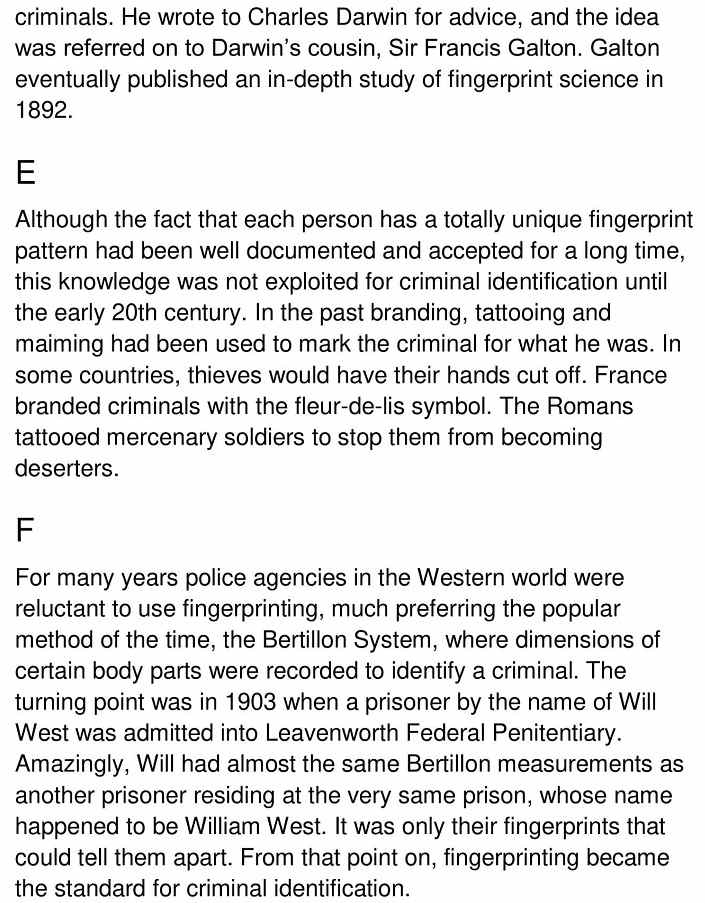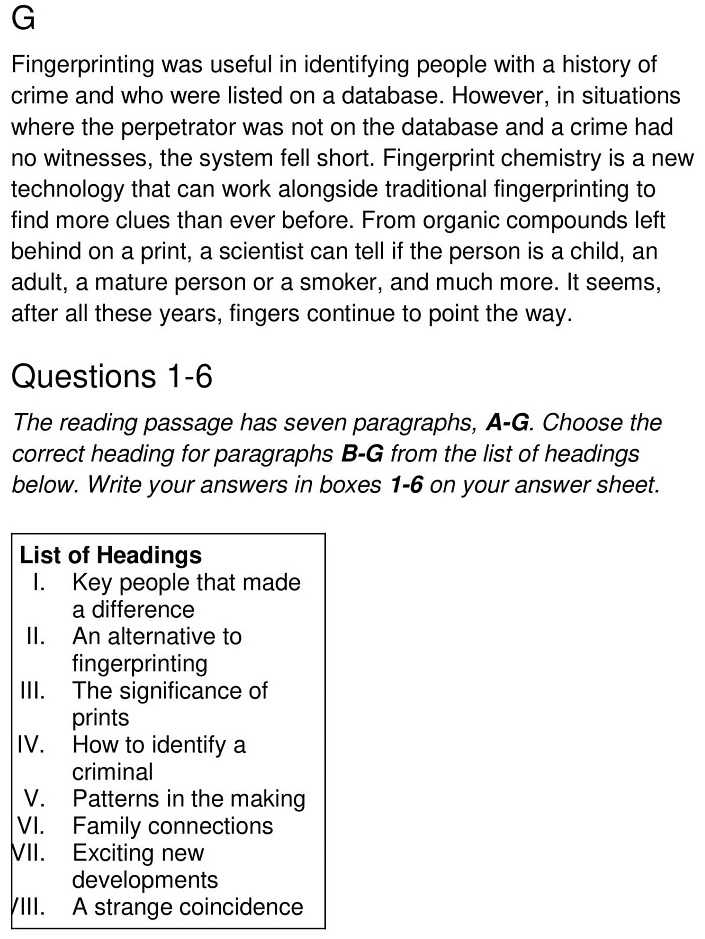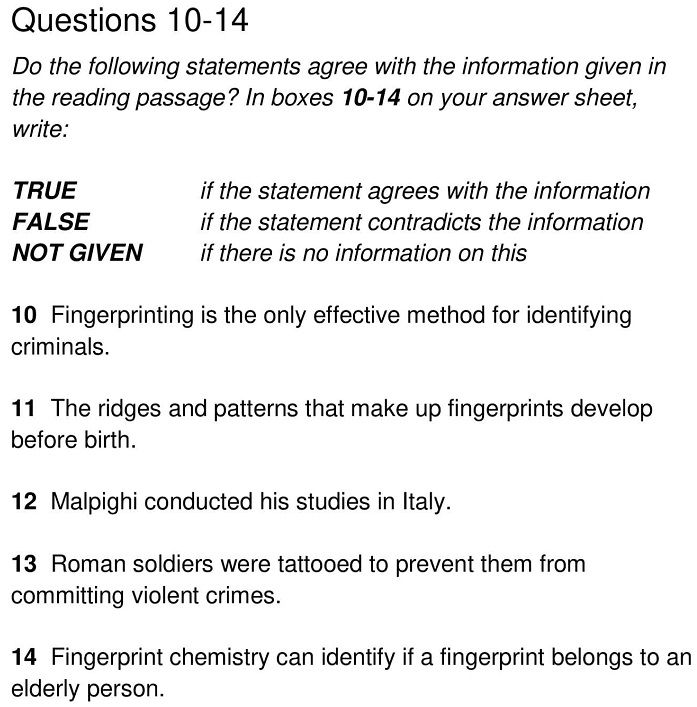A History of Fingerprinting – IELTS Reading Answers
8 min read
Updated On
-
Copy link
Table of Contents

Limited-Time Offer : Access a FREE 10-Day IELTS Study Plan!
The Academic passage ‘A History of Fingerprinting ‘ is a reading passage that appeared in an IELTS Test.
Ideally, you should not spend more than 20 minutes on a passage. Let’s see how easy this passage is for you and if you’re able to make it in 20 minutes. If not, try more IELTS reading practice tests from IELTSMaterial.com
The question types found in this passage are:
Matching Headings
In Matching Headings question, a list of headings will be given and you are asked to match these headings with a paragraph in the passage. You should read the headings before you begin reading the text. To get the correct answer, you have to read the complete paragraph and not just stop with the first few lines of the paragraph. There will also be many other headings that are not related to any of the paragraphs given in the passage, in such cases, try to identify those types of headings too.
Sentence completion
In sentence completion, you’ll be asked to fill in the blank spaces using the words given in the text. It is important to pay close attention to the instructions that are given in the question because in some instructions there will be a word limit mentioned and you may lose marks if you don’t follow it.
True/False/Not Given Questions
True/False/Not Given Questions very tricky. This question consists of several statements – If the statement is present in the article as it is then you need to mark it as true. If the statement is found to be the opposite of the sentence which is there then it should be marked as false. If the statement given in the question is not at all present in the article then it should be marked as not given. Do not spend a lot of time finding the sentence which is not there.
Answer questions 1-14 based on the given passage.
A History of Fingerprinting






Answers
The answers to questions 1-14 are given below along with their explanations.
1 Answer: v
Question Type: Matching Headings
Answer location: Paragraph B, line 1
Answer explanation: In the reference paragraph, it is given that “a good place to start is to understand what fingerprints are and how they are created. A fingerprint is the arrangement of skin ridges and furrows on the tips of the fingers.” “A good place to start is to understand what fingerprints are and how they are created” implies that it discusses the making of fingerprint patterns.
2 Answer: x
Question Type: Matching Headings
Answer location: Paragraph C, line 2
Answer explanation: Paragraph C puts forward the information that “the moment in history it happened is not entirely dear. However, the use of fingerprinting can be traced back to some ancient civilisations, such as Babylon and China, where thumbprints were pressed onto clay tablets to confirm business transactions.” The past is not very clear. So it represents an uncertain past.
3 Answer: i
Question Type: Matching Headings
Answer location: Paragraph D, line 1
Answer explanation: The answer is clearly mentioned in the said paragraph and line. You must note the paraphrasing here. In the passage, it is said that “despite this uncertainty, there are those who made a significant contribution towards the analysis of fingerprinting.” Significant people indicates key people who made the difference.
4 Answer: iv
Question Type: Matching Headings
Answer location: Paragraph E, line 2
Answer explanation: The author states “this knowledge was not exploited for criminal identification until the early 20th century. In the past branding, tattooing and maiming had been used to mark the criminal for what he was.” It suggests that branding, tattooing, and maiming were used in the past to identify a criminal.
5 Answer: viii
Question Type: Matching Headings
Answer location: Paragraph F, line 4
Answer explanation: In the said paragraph, you can refer to, “amazingly, Will had almost the same Bertillon measurements as another prisoner residing at the very same prison, whose name happened to be William West. It was only their fingerprints that could tell them apart. From that point on, fingerprinting became the standard for criminal identification.” Since Will had almost the same Bertillon measurements as another prisoner, it indicates a strange coincidence.
Unlock Answers
6 Answer: vii
Question Type: Matching Headings
Answer location: Paragraph G, line 3
Answer explanation: In the said paragraph, you can refer to, “fingerprint chemistry is a new technology that can work alongside traditional fingerprinting to find more clues than ever before. From organic compounds left behind on a print, a scientist can tell if the person is a child, an adult, a mature person, or a smoker, and much more. It seems, after all these years, fingers continue to point the way.” From the given information, we can infer the significant advancements in the field of fingerprint analysis including detecting the organic substance left on the print, determining a person’s age – whether he is a kid, adult, or mature person, and much more.
7 Answer: (human) characteristics
Question Type: Sentence Completion
Answer location: Paragraph B, line 4
Answer explanation: The entire sentence has been paraphrased here. In the passage, it states “these ridges are arranged into patterns and remain the same throughout the course of a person’s life. Other visible human characteristics, like weight and height, change over time whereas fingerprints do not.” Hence, other visible human characteristics like weight and height can undergo changes, but fingerprints do not.
8 Answer: identical twins
Question Type: Sentence Completion
Answer location: Paragraph B, last line
Answer explanation: A line in the paragraph denotes “even identical twins possess dissimilar fingerprints.” Hence, according to the passage, even identical twins do not share similar fingerprints.
9 Answer: signature
Question Type: Sentence Completion
Answer location: Paragraph D, line 5
Answer explanation: Paragraph D puts forward the information that “it was, however, an employee for the East India Company, William Herschel, who came to see the true potential of fingerprinting. He took fingerprints from the local people as a form of signature for contracts, in order to avoid fraud. His fascination with fingerprints propelled him to study them for the next twenty years. He developed the theory that fingerprints were unique to an individual and did not change at all over a lifetime.” East India Company in the past took fingerprints as a substitute for signature in Indian contracts.
10 Answer: FALSE
Question Type: True/False/Not Given Questions
Answer location: Paragraph A, line 2
Answer explanation: Fingerprinting is not the only effective method in identifying criminals because “fingerprinting offers an accurate and infallible means of personal identification. The ability to identify a person from a mere fingerprint is a powerful tool in the fight against crime.” Hence, we can infer that fingerprint is one of the powerful tools to fight against crime.
11 Answer: TRUE
Question Type: True/False/Not Given Questions
Answer location: Paragraph B, line 3
Answer explanation: A line in the passage mentions that “this ridged skin develops fully during foetal development, as the skin cells grow in the mother’s womb. These ridges are arranged into patterns and remain the same throughout the course of a person’s life.” The ridges and patterns of skin cells form (makeup) fingerprints develop before birth.
12 Answer: NOT GIVEN
Question Type: True/False/Not Given Questions
Answer location: Paragraph D, line 3
Answer explanation: The paragraph suggests that “later, in the 17th century, Italian physician Marcello Malpighi studied the distinguishing shapes of loops and spirals in fingerprints.” Though Malpighi was an Italian physician , there is no information about where he conducted his research.
13 Answer: FALSE
Question Type: True/False/Not Given Questions
Answer location: Paragraph E, last line
Answer explanation: Paragraph E puts forward the information that “the Romans tattooed mercenary soldiers to stop them from becoming deserters.” Desertion is the abandonment of a military duty or post without permission and is done with the intention of not returning. Hence, we confirm that soldiers were tattooed to stop them from becoming deserters and not to prevent them from committing violent crimes.
14 Answer: TRUE
Question Type: True/False/Not Given Questions
Answer location: Paragraph G, line 3
Answer explanation: If you read thoroughly, a line in the passage specifies that “fingerprint chemistry is a new technology that can work alongside traditional fingerprinting to find more clues than ever before. From organic compounds left behind on a print, a scientist can tell if the person is a child, an adult, a mature person or a smoker, and much more. It seems, after all these years, fingers continue to point the way.” Fingerprint chemistry is a new technology that can help to identify if the person is a child, an adult (elderly person), a mature person or a smoker, and much more.
Check More IELTS Reading Answers
Also check :
Practice IELTS Reading based on question types

Start Preparing for IELTS: Get Your 10-Day Study Plan Today!
Recent Articles

Nehasri Ravishenbagam

Haniya Yashfeen

Haniya Yashfeen

Haniya Yashfeen




Post your Comments